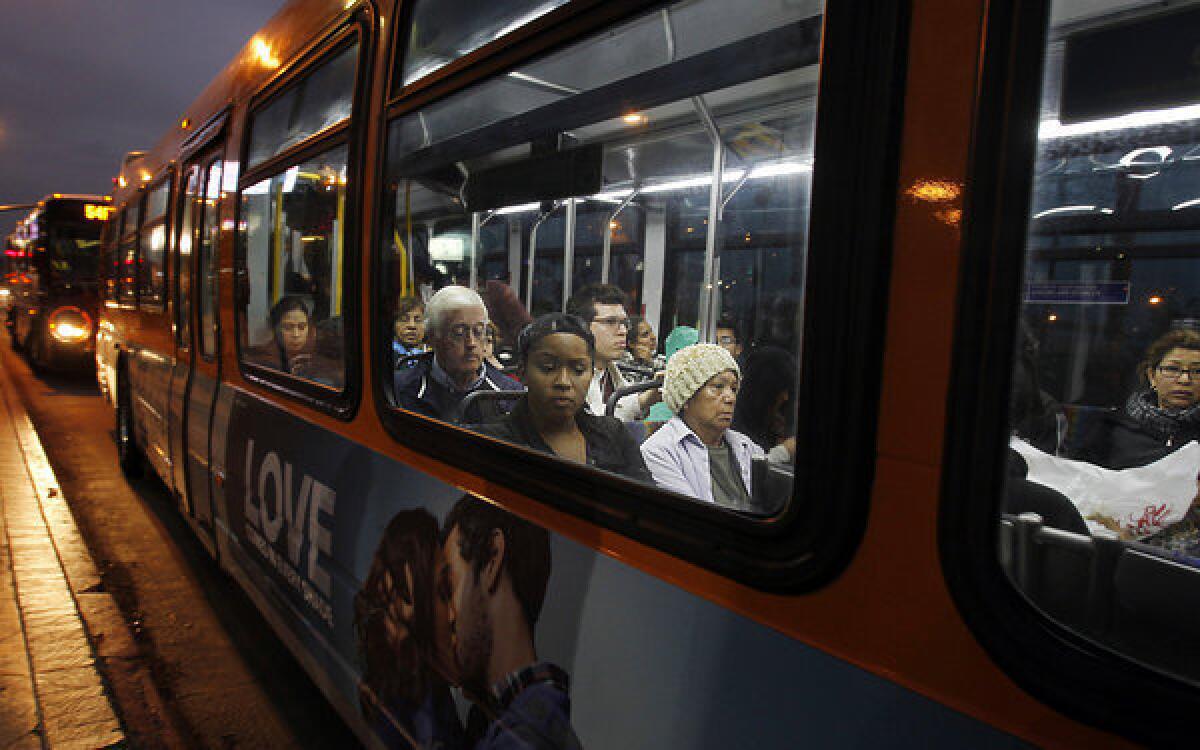Editorial: Metro’s new bus plan is useless without the political will to see it through

On four separate occasions, most recently in 2016, residents of Los Angeles County have voted to raise their own taxes to pay for more rail lines, better bus service and improved infrastructure. This is exactly the kind of investment needed to help get people out of polluting cars and onto a sustainable, modern urban transportation system.
But there is a cloud hanging over the Los Angeles County Metropolitan Transportation Authority. Despite a transit building boom, ridership is down. It’s especially down on buses, as trips have fallen nearly 25% over a decade. And slow, unreliable, uncomfortable buses are a big reason why.
Now Metro has rolled out a proposal designed to to transform L.A. beleaguered buses into a “world-class bus system.” If its NextGen bus plan is approved, Metro would begin implementation in December, starting with more frequent, reliable service on popular routes and eventually building more bus-only lanes and more comfortable bus stops and adding other infrastructure improvements.
It’s long overdue for Metro to spend serious time and energy on improving bus service. Buses carry two-thirds of Metro’s transit riders, but they’ve been largely an afterthought as Metro has spent billions of dollars to build new rail lines. The light-rail and subway lines are important assets that serve as the spine of the regional transportation system. But buses are the underappreciated workhorses that get people from their homes to work, school, the doctor and the train station. This would be the first overhaul of the region’s bus network in more than 25 years.
The plan calls for buses that arrive every 10 minutes or less — and in some cases, as frequently as every five minutes — on 29 major routes. About 83% of Metro riders could walk to a bus stop with that level of service, compared with 48% now, The Times’ Laura J. Nelson reported. There would be more evening and weekend service on some well-used routes. On the other hand, routes with low ridership could be cut back or eliminated.
The proposal also calls for Metro to spend $1 billion over five years to improve bus reliability, speed and comfort. The proposal includes $750 million for bus-only lanes, synchronized traffic signals and other improvements, and about $150 million for shelters and other changes at busy stops.
Putting the new plan in place would require some tough decisions. Some riders are going to lose their regular routes. And in addition to sacrificing some of their sidewalks for covered, seated bus stops (so riders don’t have to bake in the sun), cities will have to carve out street space for bus-only lanes, which never makes drivers happy. Indeed, bus-only lanes are essential if Metro is going to promise transit riders frequent, reliable and fast bus service. The average speed of a Metro bus has dropped 12.5% over the last 25 years as buses have gotten stuck in the same worsening traffic as cars.
Politicians in L.A. often spend their political capital on big, flashy construction projects like rail lines, rather than using their energy and urgency to advocate for better, basic bus service. Just look at Mayor Eric Garcetti’s 28 by 28 initiative, which is an ambitious proposal to accelerate major transportation infrastructure projects so they are ready in time for the 2028 Olympics. Although there are a handful of bus rapid transit corridor projects on the list, the focus has been on speeding up big-ticket, billion-dollar rail projects. L.A. needs high quality bus service today, not eight years from now, if Metro is going to stop hemorrhaging ridership.
The NextGen bus plan is a worthy start. To truly improve bus riders’ experience, Metro’s board — which is made up of local elected leaders — and city governments will have to put the interests of those riders first. That means giving buses priority over cars. It means paying for better bus service and not ignoring buses for flashier rail projects.
More to Read
A cure for the common opinion
Get thought-provoking perspectives with our weekly newsletter.
You may occasionally receive promotional content from the Los Angeles Times.










